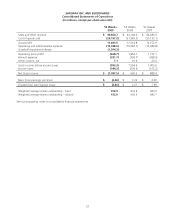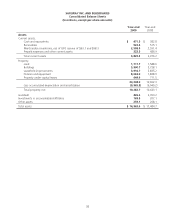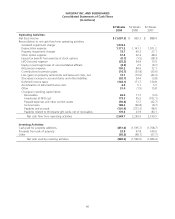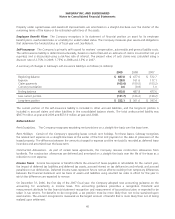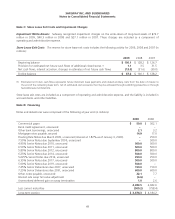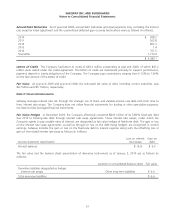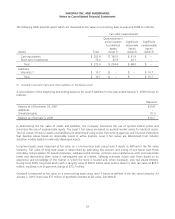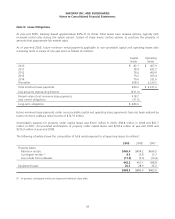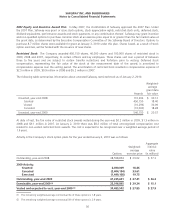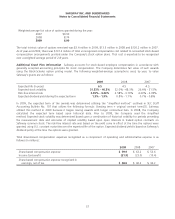Safeway 2009 Annual Report Download - page 65
Download and view the complete annual report
Please find page 65 of the 2009 Safeway annual report below. You can navigate through the pages in the report by either clicking on the pages listed below, or by using the keyword search tool below to find specific information within the annual report.
SAFEWAY INC. AND SUBSIDIARIES
Notes to Consolidated Financial Statements
the future cash flows, a provision is made for the impairment of the assets to write the assets down to estimated fair
value. Fair value is determined by estimating net future cash flows, discounted using a risk-adjusted rate of return. The
Company calculates impairment on a store-by-store basis. These provisions are recorded as a component of operating
and administrative expense.
When stores that are under long-term leases close, the Company records a liability for the future minimum lease
payments and related ancillary costs, net of estimated cost recoveries that may be achieved through subletting properties
or through favorable lease terminations, discounted using a risk-adjusted rate of interest. This liability is recorded at the
time the store is closed. Activity included in the reserve for store lease exit costs is disclosed in Note C.
Accumulated Other Comprehensive (Loss) Income Accumulated other comprehensive (loss) income, net of
applicable taxes, consisted of the following at year-end (in millions):
2009 2008 2007
Translation adjustments $ 302.7 $ 140.5 $ 367.2
Pension adjustment to funded status (408.8) (406.8) (140.7)
Recognition of pension actuarial loss, net 95.9 41.0 21.5
Other (3.6) (3.4) (1.8)
Ending balance $ (13.8) $ (228.7) $ 246.2
Stock-Based Employee Compensation Safeway accounts for all share-based payments to employees, including
grants of employee stock options, as compensation cost based on the fair value on the date of grant. The Company
determines fair value of such awards using the Black-Scholes option pricing model. The Black-Scholes option pricing
model incorporates certain assumptions, such as risk-free interest rate, expected volatility, expected dividend yield and
expected life of options, in order to arrive at a fair value estimate.
New Accounting Pronouncements Not Yet Adopted
In January 2010, the Financial Accounting Standards Board (“FASB”) issued guidance which amends and clarifies existing
guidance related to fair value measurements and disclosures. This guidance requires new disclosures for (1) transfers in
and out of Level 1 and Level 2 and reasons for such transfers; and (2) the separate presentation of purchases, sales,
issuances and settlement in the Level 3 reconciliation. It also clarifies guidance around disaggregation and disclosures of
inputs and valuation techniques for Level 2 and Level 3 fair value measurements. This guidance is effective for Safeway
for the first quarter of fiscal 2010, except for the new disclosures in the Level 3 reconciliation. The Level 3 disclosures are
effective for Safeway for the first quarter of fiscal 2011. Safeway does not expect that this guidance will have a material
impact on its consolidated financial statements.
In June 2009, the FASB issued guidance for the consolidation of variable interest entities (“VIE”). This guidance
establishes a new criteria for determining the primary beneficiary. It also requires an ongoing assessment to determine
whether a company is the primary beneficiary of a VIE. The guidance is effective for Safeway beginning in fiscal 2010.
Safeway does not expect that this guidance will have a material impact on its consolidated financial statements.
Note B: Goodwill
Goodwill represents the excess of cost of an acquired business over the fair value of the identifiable tangible and
intangible assets acquired and liabilities assumed in a business combination. Goodwill is not subject to amortization but
must be evaluated for impairment.
47


